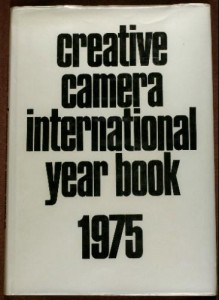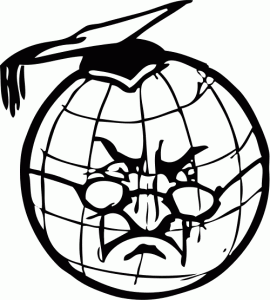 [Forty years ago, in 1975, I published another installment of what had become an ongoing rumination on the state of post-secondary photography education. It appeared in the Creative Camera International Year Book 1975; you’ll find it also in my 1979 collection of essays, Light Readings. Portions of it still seem relevant to the current condition of that now much expanded industry. I offer it here to any graduating class that wants it, free of charge, as a commencement address from an uninvited guest speaker. The second part appears below. Click here for the first part. — A. D. C.]
[Forty years ago, in 1975, I published another installment of what had become an ongoing rumination on the state of post-secondary photography education. It appeared in the Creative Camera International Year Book 1975; you’ll find it also in my 1979 collection of essays, Light Readings. Portions of it still seem relevant to the current condition of that now much expanded industry. I offer it here to any graduating class that wants it, free of charge, as a commencement address from an uninvited guest speaker. The second part appears below. Click here for the first part. — A. D. C.]
•
My Camera in the Olive Grove:
Prolegomena to the Legitimization of Photography
by the Academy (continued)
When the economic bubble burst at the beginning of the 1970s, many of these young photographers found themselves redundant. The job market in teaching creative photography began to dry up, the competition became stiffer, and the ability to make personal images, even interesting ones, was no longer enough to guarantee one gainful employment in some school somewhere.
Those schools now hiring teachers of photography are in a position to pick and choose, so they are beginning to require credentials beyond a camera, a portfolio of prints, and a sheepskin. Generally, they are coming to expect applicants to be adept at all the various photographic processes, old and new, even if they don’t employ such means in their own work. Increasingly, they expect candidates to have enough of a background in the history of photography to teach that subject as well. Often they require some training in teaching, which is a craft in itself. And, as a more interdisciplinary approach to photographic education at last begins to flower, schools are starting to sift through the mass for those who are able to teach photography not only as a means of introspective self-expression but as a major language form — one whose communicative effectiveness can be of value to students from such diverse disciplines as sociology, history, and psychiatry. [Note: Wishful thinking, alas, those last two sentences. Post-secondary photo ed still requires no training in teaching, and remains as unmultidisciplinary as ever. — A. D. C.]
 Naturally, this puts the squeeze on those who are really only in it for the money, a fact which Peter Bunnell bemoans in the statement quoted above. I feel quite differently about it: the last thing photography needs, at this point or any other, is a generation of students whose instructors viewed teaching not as a calling but as a sinecure. Whichever of these attitudes one agrees with, the fact is that education is currently metamorphosing from the guild-derived master-apprentice relationship to the professor-scholar symbiosis of the academy, and that this is occurring at a time when there is an unprecedented demand for photography education but an oversupply of would-be teachers.
Naturally, this puts the squeeze on those who are really only in it for the money, a fact which Peter Bunnell bemoans in the statement quoted above. I feel quite differently about it: the last thing photography needs, at this point or any other, is a generation of students whose instructors viewed teaching not as a calling but as a sinecure. Whichever of these attitudes one agrees with, the fact is that education is currently metamorphosing from the guild-derived master-apprentice relationship to the professor-scholar symbiosis of the academy, and that this is occurring at a time when there is an unprecedented demand for photography education but an oversupply of would-be teachers.
Under such circumstances, any association whose imprimatur is convertible to heightened employability and/or job security is in a position of power. With such power comes politics.
•
“Artists now not only admit to but are acutely aware of what they once only suspected and often avoided; that the central theme of their picture-making is imagery itself.” — William Jenkins, “Some Thoughts on 60’s Continuum,” Image, Vol. 15, No. 1, March 1972
What differentiates an academy from a guild or union is that the academy concerns itself with transmitting not just craft competence but ideas as well. It is precisely in this regard that an academy always poses a threat to the medium it nominally represents. By definition, the purpose of an academy is to formalize the history of its medium by the analysis, annotation, and codification of that medium’s traditions. But traditions, by definition, cannot be thus regimented and reduced to formulae.
As John Szarkowski has written, artistic tradition “exists in the minds of artists and consists of their collective memory of what has been accomplished so far. Its function is to mark the starting point for each day’s work. Occasionally it is decided that tradition should also define the work’s end result. At this point the tradition dies.” (Looking at Photographs; 100 Pictures from the Collection of the Museum of Modern Art, 1973). Once an institution such as an academy becomes the source or reference point for the traditions of a medium, those traditions become fixed, immobile, and begin to lose their vitality. They cease to operate as traditions and instead are converted into conventions.
Conventions, like standards, are embodiments of competence. But creativity and competence are often incompatible with each other. This is not to say that incompetence is a virtue; but from a creative standpoint, a state of acompetence is often a necessity. Competence, after all, directs its possessor towards the duplication of what has already been done via the employment of time-tested, foolproof procedures. Creativity, on the other hand, is a form of acompetence aimed at generating that which has never before existed and which therefore has no pre-set rules to guide its making, no extant model by which its success or failure can be measured. Creative activity is essentially anarchic, incorporating accident, risk, innovation, abnormality, change.
An art academy is therefore almost always a contradiction in terms. Conservative by nature, devoted (like all institutions) to stability out of self-preservation, an academy seeks to maintain the past in the present by molding the present with the past. Such an organism, whose phase is predominantly entropic, is automatically at loggerheads with its medium’s avant-garde. For it is always the latter who are disregarding and/or deliberately violating their medium’s history and traditions, breaking through the boundaries on the academy’s maps in order to keep their medium alive and growing. Historically, an academy’s relationship to the living pioneers in its medium has usually been an antagonistic one, since academies are bastions of conventionalism while subversion of the established order — emotional, aesthetic, political, philosophical, and cultural — lies close to the heart of the creative impulse. Academies tend to be the mausoleums of tradition, as museums tend to be the graveyards of art.
Often there are positive benefits to be derived from the presence of an active academy within the larger context of a living medium. Some of these we are already beginning to reap. Among them are the spread of craft competence; the organization of an informational network, and a consequent increase in the rapidity of communication; the preservation of significant creative works and research materials; an increased attention to the medium’s history and development; revitalization of still-viable methods and processes (such as the non-silver processes of the late nineteenth century, which will be newly useful in the silverless late twentieth century); and the power, respect, and money which accrue to academically established media as a rule.
 These are unobjectionable in and of themselves, but there is a flip side to most of these coins, a price to pay. Overemphasis on craft competence can deaden creativity. A short-circuited informational network of the sort William Jenkins waxes so enthusiastic over can rapidly become inbred and anemic (a demonstrated tendency of academicized creative activity). Western culture’s obsession with permanence and immortality manifests itself in our continual warehousing of the past. The scrutiny of art isolated from the personal and cultural contexts in which it grew leads to the dry, reductivist formalism of “photographs about photography.” And too much time in the ivory tower can convince one that life imitates art — or, indeed, that art replaces life.
These are unobjectionable in and of themselves, but there is a flip side to most of these coins, a price to pay. Overemphasis on craft competence can deaden creativity. A short-circuited informational network of the sort William Jenkins waxes so enthusiastic over can rapidly become inbred and anemic (a demonstrated tendency of academicized creative activity). Western culture’s obsession with permanence and immortality manifests itself in our continual warehousing of the past. The scrutiny of art isolated from the personal and cultural contexts in which it grew leads to the dry, reductivist formalism of “photographs about photography.” And too much time in the ivory tower can convince one that life imitates art — or, indeed, that art replaces life.
Those are some of the risks on the down side insofar as the existence of a photography academy is concerned. Yet, in considering that eventuality, it is imperative to do more than merely strike some balance between these advantages and drawbacks. As noted previously, photography education is at a point of transition. The key problems facing us at this juncture are: the development of a nonsectarian vocabulary; the shaping of a methodology for teaching the fundamentals of visual communication with photography to workers in all disciplines, not only to “art photographers”; and the broadening of the base of photography education so that photography becomes a tool as basic as writing, taught from grade school on up to all members of our society.
These are not insoluble problems, but they are inarguable priorities. If the new academy can provide assistance in solving them in the most productively visionary fashion possible, then its presence will be a positive factor in the medium’s evolution.
If, however, the photography academy proves to be such deadweight as only a bastion of tradition can be, we might do well to remember that photography has already altered permanently the ways in which we experience our world and understand our experience. Photography has done so entirely without an academy of its own, and often over the active opposition of the larger academic community. Under such circumstances, it would not be ill-advised to retain the option of reverting to bastardy, should that involve losing nothing more than the dubious distinction of the good name of Art.
(Part 1 I 2)
•
This essay appeared originally in Osman, Colin, ed., Creative Camera International Year Book 1975 (London: Coo Press, 1975), pp. 162-65. Subsequently reprinted in Coleman, A. D., Light Readings: A Photography Critic’s Writings, 1968-1978 (first ed. New York: Oxford University Press, 1979; second ed. Albuquerque: University of New Mexico Press, 1998), pp. 195-202.
© Copyright 1975 by A. D. Coleman. All rights reserved. By permission of the author and Image/World Syndication Services, imageworld@nearbycafe.com.







Hi A.D.
I remember well 1974 when I got out of cal arts with my NRA thinking I would get a teaching job so I could continue to do my personal work. it took me two yrs to realize that wasn’t in the cards. that I and the academy were not a good match.
Enjoy reading you current missives.
Barry